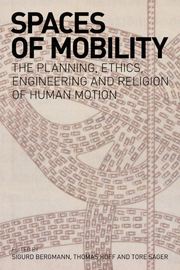Book contents
- Frontmatter
- Contents
- List of illustrations and tables
- Contributors
- Preface
- Acknowledgements
- 1 The beauty of speed or the cross of mobility? Introductory reflections on the aesth/ethics of space, justice and motion
- Part I
- Part II
- Part III
- 8 Mobility: discourses from the non-Western immigrant groups in Norway
- 9 Inclusive mobility: participation, physical barriers and the concept of universal design
- 10 Freedom as mobility: implications of the distinction between actual and potential travelling
- Index
8 - Mobility: discourses from the non-Western immigrant groups in Norway
from Part III
- Frontmatter
- Contents
- List of illustrations and tables
- Contributors
- Preface
- Acknowledgements
- 1 The beauty of speed or the cross of mobility? Introductory reflections on the aesth/ethics of space, justice and motion
- Part I
- Part II
- Part III
- 8 Mobility: discourses from the non-Western immigrant groups in Norway
- 9 Inclusive mobility: participation, physical barriers and the concept of universal design
- 10 Freedom as mobility: implications of the distinction between actual and potential travelling
- Index
Summary
Introduction
Technological and social developments are not mutually exclusive forces. Mobility, one of these forces, exists in a perpetual state of symbiosis between technology and society. Although this concept can be found in various disciplines, including civil engineering, transport planning, geography and social and development theory, mobility still remains marginalized in its visualization as a convergent and divergent resource and a product that crosscuts these disciplines. This calls for a more coherent and comprehensive conceptualization of the idea. The following essay analyses mobility in the context of transport planning but ventures beyond its restrictive borders and attempts to extend the discourse surrounding this theme. As Peter Jones (1987: 45) notes, the proposition that travel-related mobility problems need to be studied in the broader context parallels a similar concern voiced in many other subject areas on the need to broaden the context in which topics are examined. Fritjof Capra (1982) outlines similar developments in the fields of physics, medicine and economics, as researchers in these areas also get to grips with the notion of society and life as much more interconnected phenomena than was appreciated within the Newtonian-Cartesian mode of thought (as quoted in Jones 1987: 45).
An interesting expression of the way transport and physical mobility is a doxa of social theory is Anthony Giddens's analysis of modernity (1991). The phenomena he addresses, such as the change of meaning of time and space, the dialectic of disembedding and re-embedding and the circularity of the universal and local, clearly depend on the sociotechnological system of mobility.
- Type
- Chapter
- Information
- Spaces of MobilityThe Planning, Ethics, Engineering and Religion of Human Motion, pp. 177 - 204Publisher: Acumen PublishingPrint publication year: 2008



